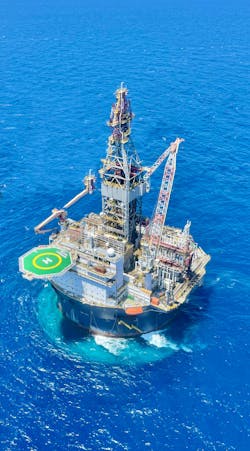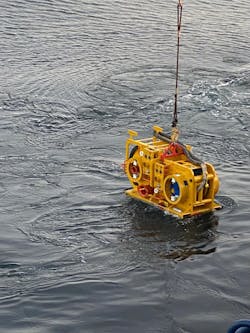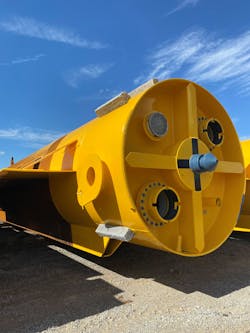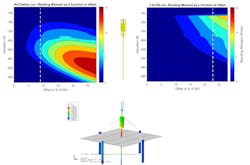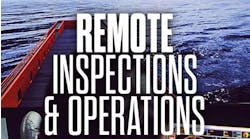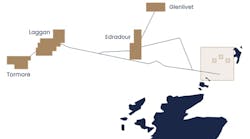Subsea tethering system enables DP semi to drill in shallow-water GoM
Editor's note: This story first appeared in the November-December 2022 issue of Offshore magazine. Click here to view the full issue.
By Ray Smith, Walter Oil & Gas Corp.; Kevin Chell, Trendsetter Vulcan Offshore; Steven Wascom, Seadrill; and James Soliah, Delmar Systems
Hurricane Katrina and the Macondo incident irrevocably changed drilling in the Gulf of Mexico (GoM), and the ensuing regulatory environment introduced requirements that disqualified some drilling units from operating in the area without modifications. This situation, compounded by market dynamics, altered the face of the operating fleet. Today, nearly all the units in the region are dynamically positioned (DP) vessels, and that complicates things for operators looking to develop shallow-water acreage.
Watch circles and safety
The usual approach to drilling wells in 1,500 ft water depth or less is to use moored rigs because once securely positioned, they hold their station reliably over the wellhead. Using a DP rig in place of a moored unit at these depths introduces station-keeping challenges that can lead to unsafe conditions.
The watch circle of the rig, the area in which the drilling rig maintains its intended position to avoid exceeding equipment and reaction time limitations, is quite small in shallow water. Even small movements at the surface can have a significant impact at the seabed, increasing loads on the wellhead and introducing safety risks.
A rig using a DP system in shallow water is at greater risk than a moored vessel of moving outside the watch circle, in part because precise station-keeping in shallow water is challenging even when the system is working as designed. If one of the thrusters fails, the DP system struggles to keep the unit on station. A vessel experiencing drive-off in shallow water can quickly reach a point at which surface displacement threatens wellhead integrity, as the time required to disconnect the riser from the BOP can be longer than it takes for the loads begin to damage the well structure.
To safely operate a DP rig in shallow water, there must be a way to eliminate the likelihood of a drive-off or a way to ensure wellhead integrity if a drive-off occurs.
Considering available solutions
In 2016, Walter Oil & Gas began planning its upcoming shallow-water exploration program. Historically, Walter had used a moored unit for this type of field in the GoM, but no moored vessels were available. To proceed, Walter needed to evaluate alternative approaches that would work in water depths as shallow as 350 ft.
The operator was somewhat apprehensive about employing a DP rig due to the concern that station-keeping would be an issue. If the vessel could not stay on location, it could potentially impart loading to the wellhead that could be damaging. Walter discussed this with the regulatory authorities, which shared the operator’s concerns.
Walter reviewed several options to determine the best way forward. The first examined the possibility of increasing the size of wellhead system to provide the strength to allow more lateral movement at the surface, but this was not economically feasible. The next possible solution was to use a gravity-base structure around the wellhead, but because of soil stability issues, the structure would have been too large to provide an affordable solution. Then, Walter evaluated introducing a weak link in the riser system as a potential point of failure that would allow the BOP to stay safely on the wellhead while the riser above the BOP failed. In the end, Walter was unable to design a weak link strong enough to function reliably and safely for work to be carried out but weak enough to fail before the BOP.
Having worked with DP operations for years, the engineering team at Walter knew that a DP rig could drill in shallow water. In fact, it already had been done successfully in the North Sea. The company was sure an economically feasible engineering solution could be developed for the GoM as well, but there were technical issues that would need to be resolved.
Walter accomplished this with a three-phase approach. First, the company focused on tethering analysis, then analyzing the DP and BOP systems, and finally demonstrating that the complete system could provide well control and station-keeping at the required depth.
Mitigating wellhead loads
Walter engaged several engineering service companies, including Trendsetter Vulcan Offshore (TVO), to determine the requirements for using a DP rig to develop its shallow-water well.
TVO has been resolving wellhead loading and fatigue issues for some time and has developed a means of arresting the motions of the BOP using a tethering system comprising piles and tensioners. The system holds the BOP in place and transfers loads to the tethering system, piles, and seabed instead of the wellhead. The tethering system arrests the motion of the BOP stack above the wellhead, substantially reducing wellhead cyclic stresses and enhancing fatigue life.
Walter began discussions with TVO to determine the feasibility of modifying this system to make it strong enough to shift the failure point above the BOP mandrel if the rig were unable to execute an emergency disconnect from the wellhead.
Securing a semi
Meanwhile, Walter needed a rig. The company chose Seadrill’s Sevan Louisiana in part because of its shape. This semi is the third in a series designed with a circular hull that enables it to respond well to wind and waves. The hull allows the rig to hold its position without turning, making it extremely stable, a critical requirement for this shallow-water drilling program. A skirt on the hull of the vessel, an improvement to the original design, further improves its stability.
Walter’s decision to use a semisubmersible on this field was based partly on the omnidirectional capabilities of a semi’s DP system. Unlike a drillship or traditional semi, the fully DP circular unit can easily accommodate changes in waves. The Sevan Louisiana is outfitted with a Kongsberg Class 3 system with eight thrusters, two in each quadrant. The redundancy on the electrical systems that power the four engine rooms controlling the thrusters allows a breaker to be opened to make each engine room independent, a design that minimizes the chance of complete quadrant failure. If one engine room trips, there are three engine rooms with six engines to keep the vessel on location.
The rig specifications alone were appealing, but Walter’s decision to work with Seadrill was made in part because of the drilling contractor’s willingness to cooperate in developing a solution that would allow the Sevan Louisiana to be used at the required water depth. Seadrill had already carried out independent analysis of motion characteristics of one of its rigs and did the same for two additional units to demonstrate the ability to work at 350 ft water depth.
Optimizing the system
Sophisticated modeling was required to determine if the vessel’s station-keeping ability was adequate to keep it on location in shallow water.
TVO had used its proprietary lower-capacity tethering system, called Mars, to reduce wellhead fatigue in the North Sea and had a good understanding of the issues with which the GoM system would have to contend. However, prior analysis had not had to consider loop currents and associated vortex shedding in a shallow-water environment.
Mars is designed for fatigue mitigation. The function of the GoM system would be different, but the Mars system and learnings from the installations provided a foundation for developing a high-capacity system for the GoM.
The high-strength tethering system, Hercules, had been conceptualized but had not yet been developed. The TVO team began the process by determining the load necessary to pull the BOP when the rig drifted off the well. With the load defined, design work for the winches, suction piles, and the yoke that would connect the tethers to the BOP could begin. The system is much stronger and stiffer than the Mars system.
Foundations for the tensioners are a critical part of the tethering system. Because of the soft soil conditions in the GoM, TVO elected to use large suction piles for the installation and looked to partner with Delmar Systems in Louisiana. Delmar, which had developed high-capacity suction piles for mooring in the GoM, employed its in-house geotechnical engineering team to analyze the requirements.
The existing mooring piles were designed for loading below the mudline, but the load would be applied above the mudline in the tethering system. The Delmar team had to determine how the suction piles would react so they could modify them to provide the necessary lateral loading capacity.
Suction piles had not previously been used in this configuration, and there was no industry standard to apply; so Delmar worked with Walter and TVO to define acceptable performance criteria.
TVO performed the global riser analysis and defined the stiffness required for the system, recognizing that the drive-off conditions would affect the stiffness. Delmar used that data to determine how to modify the piles to deliver the required holding capacity. An iterative process of feeding pile positions, capacities, and deflections into the TVO model led to a solution – attaching wings to the sides of the piles to provide greater lateral capacity.
At the same time, TVO was designing, building and testing equipment and customizing it for the Sevan Louisiana. Full-scale physical tests ensured the tethering system could withstand the required load.
While developing the tethering system, engineers also examined the BOP and looked for ways to decrease the time required to close in and lift off the well so the watch circle could be expanded.
Another big piece of the puzzle was fine tuning the DP system. The system was modeled using three years of real-time data, to decrease the amount of time required to react to environmental changes. The process of adjusting the tethers was managed by the offshore crew and relied on the Seadrill team to not only collaborate but take on the task using new technology. With the DP system optimized, the Sevan Louisiana has remained within 6-8 ft. of its tethered position during normal operations.
System installation
The BOP needed modifications to allow the tethering system to attach. TVO and Seadrill determined where the attachment points for the tensioners should be placed. The equipment retracts within the frame of the BOP such that there is no interference during deployment and retrieval. While the Sevan Louisiana was in transit to the well, the crew attached yokes that had been built and pretested by TVO so the BOP would be tethering-ready when the vessel arrived.
For prior tethering system installations, the seabed was prepared before the arrival of the rig to simplify rig-up. In this case, the Sevan Louisiana was already on site when the installation got underway. Because the installation vessels had to navigate around the rig, the process was somewhat more complicated, but the piles and tensioners were placed without incident.
A subsea intervention vessel fitted with a crane and two ROVs installed the modified suction piles and infrastructure to install tether winches. Preparation work for the drilling program was carried out concurrently on board.
Other than weather-related downtime, there were no issues with the process. The installation was completed within 10% of the time estimated.
Tethering system at work
Once the components of the tethering system are connected, it is a passive system. If DP keeps the rig on location, the system functions as “insurance.” In the case of a drift-off, any increased load from the riser is transferred to the tensioners and suction piles to ensure well integrity is not compromised.
Daily ROV checks on the load cells on the BOP yoke ensure that everything remains within the acceptable range. If loads are outside the range, the tensioners are reset by the rig ROV.
Walter engineers have analyzed the tethering system and determined that the tethers completely eliminate vibrations in the wellhead.
What’s next
The problem resolved by the TVO tethering system is not confined to the GoM. Rig availability continues to plague shallow-water operators around the world, and many companies are struggling to find ways to drill wells economically in these areas. This is an engineering challenge for the entire industry.
Necessity has altered the playing field, and the successful installation of the tethering system on the Sevan Louisiana introduces a way to explore shallower water depth prospects around the world using deepwater DP rigs.
About the authors
Kevin Chell is Vice President at Trendsetter Vulcan Offshore in Houston. He has served in leadership positions in multiple organizations in the global upstream oil and gas sector. He holds a BSc in Civil Engineering from Imperial College, London, (1982) and an MBA from Cranfield University in Cranfield, England (1990).
Ray Smith is Special Projects Engineer at Walter Oil and Gas Corp. in Houston. He previously served as VP Operations at Precision Drilling, Area Manager of Operations at Diamond Offshore Drilling, and as an Ensign in the US Navy. He holds a BS Degree in Civil Engineering (1981) from the University of Florida.
Steve Wascom is Director of Operations for Seadrill in Houston. He served in US Navy as a Lieutenant prior to entering the oil and gas industry with Transocean, where he held offshore and onshore positions and became a rig manager. He joined Seadrill as Rig Manager in 2008. Wascom holds a BA Degree in History (1988) from Texas A&M University, a BS Degree in Marine Transportation (1994) from Texas A&M University, and a USCG Master Mariner License.
James Soliah is the Commercial Director, Americas at Delmar Systems, Inc. in Houston. He has served as Subsea Manager for Delmar and held multiple subsea related positions at KBR and Oceaneering International. He holds a bachelor’s degree in Ocean Engineering from Texas A&M University (1993) and is an ASCE OTC Hall of Fame Award winner and a member of API, ASCE, IADC, SPE, MTS, SNAME. He has held board positions with the SUT and is active on the Texas A&M University Ocean Engineering department advisory board.

